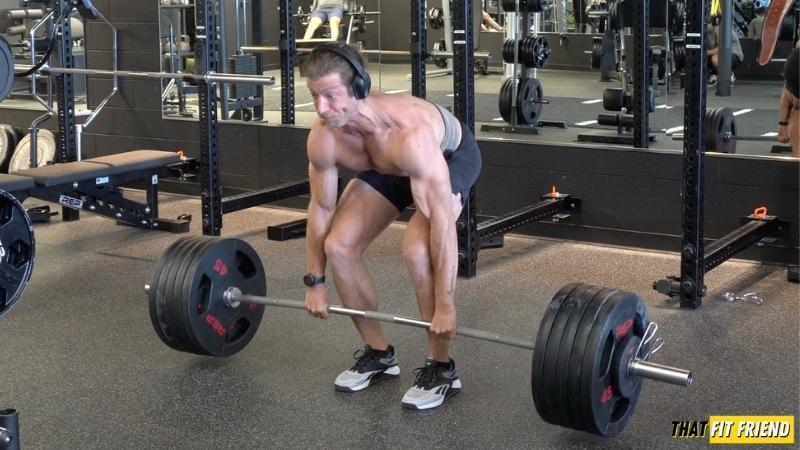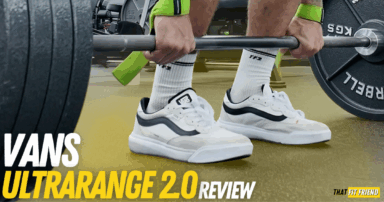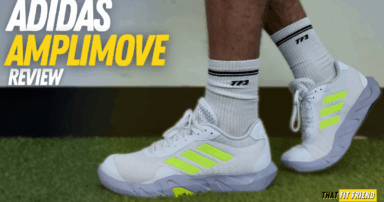The hook grip deadlift is a style of deadlifting that is not for the faint of heart. There are multiple ways to grip deadlifts and hook grip is arguably one of the toughest grip styles to learn and acclimate to.
If you ever deadlift with me or work with me as a client in this lifetime, then you’ll learn that I’m a big proponent of using hook grip for deadlifts. Is it a must for deadlifts? Absolutely not, but it is deadlift grip that I think everyone should have some exposure to.
In this hook grip deadlift guide, I’ll discuss why hook gripping deadlifts can be awesome and discuss my favorite tips for acclimating to hook grip.
Hook grip deadlifts are an awesome way to lift big weight. The hook grip is an extremely secure gripping style that will help prevent upper-body imbalances that can be built by consistently doing mixed grip deadlifts.
Hook Grip Deadlift Benefits
In my opinion, the hook grip deadlift comes with more benefits than mixed grip deadlifts. Granted, I recognize that this is my own bias speaking, but when you consider security and sport carryover hook grip deadlifts tend to reign superior.
Below are some of my favorite reasons and benefits for using hook grip deadlifts. If you have additional benefits that you’ve come across with hook grip deadlifts, drop them below in the comments.
1. Fantastic Deadlift Security
There’s a reason hook grip is often referred to as using a “natural lifting strap”. A lifting strap is a piece of supportive strength gear that gives you a ton of security when gripping barbells, dumbbells, and machines.
I’d compare a hook grip’s security when deadlifting as being nearly similar to lifting straps. While there will always be some discrepancy between your hands and a strap, a good hook grip can be pretty close regarding barbell security.
By folding the fingers over the thumb, you limit the chance of the barbell rolling out of the hands which is something that can happen when doing mixed grip deadlifts. Plus, if you have good knurling and big enough hands, forget about it — your security is set.
Whether you’re pulling heavy deadlift singles or high-volume sets, it’s really tough to beat the security of a good hook grip which is why it’s the biggest benefit of this grip style.
2. Useful for Strength Sports
Another benefit of hook grip deadlifts is that they carry over to other strength sports. For example, if you ever want to dabble in CrossFit or weightlifting, then you’ll want to have a strong hook grip.
While you don’t necessarily need a good hook grip to be competitive at CrossFit, it can certainly help with the weightlifting carryover. When snatching and clean & jerking, you’ll want to use a hook grip once you get to heavier weight.
Your traditional grip will only go so far with weight on the bar and you can’t use a mixed grip snatching and clean & jerking. By improving your hook grip deadlift, you’ll also get a nice carryover to weightlifting and sports like CrossFit.
It’s also a skill and tool that I think everyone should have some experience with because as we train, our goals constantly shift and you don’t want to have your hook grip be the pain point when trying new sports when your strength and athleticism may already be there.
3. Can Help Prevent Imbalances
A more controversial benefit that comes with hook grip deadlifts is that they can at times be useful for limiting upper-body imbalances that can come along with performing mixed grip deadlifts without ever changing the orientation of your hands.
While research is still inconclusive on imbalances as being a major hindrance to performance, it can still be useful to consider how a hook grip deadlift will influence upper body growth and strength.
More specifically, I think it’s important to recognize that when we discuss imbalances we need additional context. For the deadlift, if you’re constantly using mixed grip then you’ll typically start to notice that your back muscles develop a little more asymmetrically.
This is not necessarily a bad thing, so please don’t think this is an attempt to scare you from using mixed grip. However, if you are able to use a hook grip and can acclimate to doing so, then you’ll never have to stress balancing out your mixed grip pulling.
When you grip a barbell with a double overhand setup as you do with hook grip deadlifts, your lats, upper back, and torso muscles will perform in a similar means when completing reps whereas there can be more discrepancies when using a mixed grip.
In a mixed grip deadlift, the open and close palm will change how you create tension on each side of the body slightly, and over time this can influence once again the strength and hypertrophy of certain muscles used with this pulling style.
How To Acclimate to Hook Grip
If you’re new to hook grip, then you’ll want to buckle up because the acclimate process can be a little painful and frustrating. I think it’s important to recognize that hook grip is going to be uncomfortable when you’re first learning this grip style.
The knurling pressing into the thumb and the pressure on the thumb can feel offputting, but note, this is normal and part of the process. Also, newer barbells can be a little harsher to learn with so I often suggest starting to learn hook grip with moderately used barbells.
Coaching Tip: There are endless ways to acclimate to using hook grip for your deadlifts and we’ll all be different regarding how fast this process takes place and how we interpret the barbell pressing into the thumbs. Below is a program that can get you started with hook grip.
- Deadlift Sessions 1-5: Only use hook grip on your warm-up sets. This will help you get used to this grip style when using lighter weighs. On your final warm-up hold your last rep for 5-10 seconds.
- Deadlift Sessions 6-8: Use hook grip for your warm-up sets and your first two working sets. On your final rep of your working sets add a 2-5 second hold on your final rep.
- Deadlift Sessions 9-12: Use hook grip for all of your sets and let the real hook grip grind begin!
Don’t be afraid to manipulate the timelines above if you want more or less time working with certain deadlift intensities when using hook grip. If you’re not used to barbell knurling or have sensitive hands then you may take longer to acclimate and that’s okay.
Mixed Grip Deadlifts Vs Hook Grip Deadlifts
When talking about maximal deadlift grip security, then you’ll typically see mixed grip deadlifts compared to hook grip deadlifts. Both of these grip styles continually prove to be plenty secure for most lifters’ needs.
- Mixed Grip Deadlift: Mixed grip deadlifts involve gripping a barbell with one hand closed and positioned more traditionally with the opposing hand facing outward. One hand has a closed palm while the other is open.
- Hook Grip Deadlift: Hook grip deadlifts involve gripping the barbell with a double overhand setup, but as opposed to letting the thumb rest on top of the fingers you’re going to wrap the fingers over the thumb and grip.
While both deadlift grip styles work well, I think if we look at which of these two is the best deadlift grip style, then a strong case could be made for hook grip.
Hook grip deadlifts will give you more versatility, can tend to be more secure, and will limit potential upper-body imbalances built with consistently doing mixed grip deadlifts.
I think the one major knock against hook grip deadlifts versus mixed grip deadlifts is how long and uncomfortable acclimating to hook grip deadlifts can be. Mixed grip deadlifts can be a lot easier for beginners wanting to increase their deadlift grip security fast.
When to Use Hook Grip Deadlifts
There’s no “right” or “wrong” time to start using and implementing hook grip deadlifts, however, I do think there are more productive approaches depending on your training goals. Below is my coaching opinion on using hook grip deadlifts.
If you’re a recreational lifter then I’d suggest building your grip for as long as you can and then switching to a hook grip deadlift as the weight on the bar exceeds what you can hold with a double overhand grip.
For example, let’s say you’re doing a 5×3 with an ascending load to a top set of around 1-2 reps in reserve. Use a double overhand grip until the weight exceeds what you can handle with this grip style, then switch to hook grip.
This can be an easy way to increase your grip strength while also utilizing hook grip to pull more weight. So basically, use hook grip once the weight on the bar exceeds what you can pull with good mechanics with a double overhand grip.
If you’re a strength sports athlete that competes or plans to compete in powerlifting, weightlifting, and CrossFit, then you’ll want to utilize hook grip for sets and workouts where you want to conserve grip strength and get the most security possible.
There’s also the component of skill acquisition and specificity for strength sports athletes using hook grip deadlifts. Basically, you don’t want to run into issues during competition so using hook grip more often may be a good call for this context.
Takeaway Thoughts
Whether you’re new to lifting or a weathered athlete, it’s probably a good idea to familiarize yourself with hook grip deadlifts. This grip style is incredibly secure and it can allow you to move more weight across different strength sports.
I also think hook grip is worth exploring for lifters that are concerned about mixed grip deadlifts causing upper body discrepancies.
If you have additional questions about hook grip deadlifts, drop a comment below or reach out to me personally via Instagram (@jake_boly or @that_fit_friend).




















Afsha Konai
very well explained, thank you
Stoked it helped!